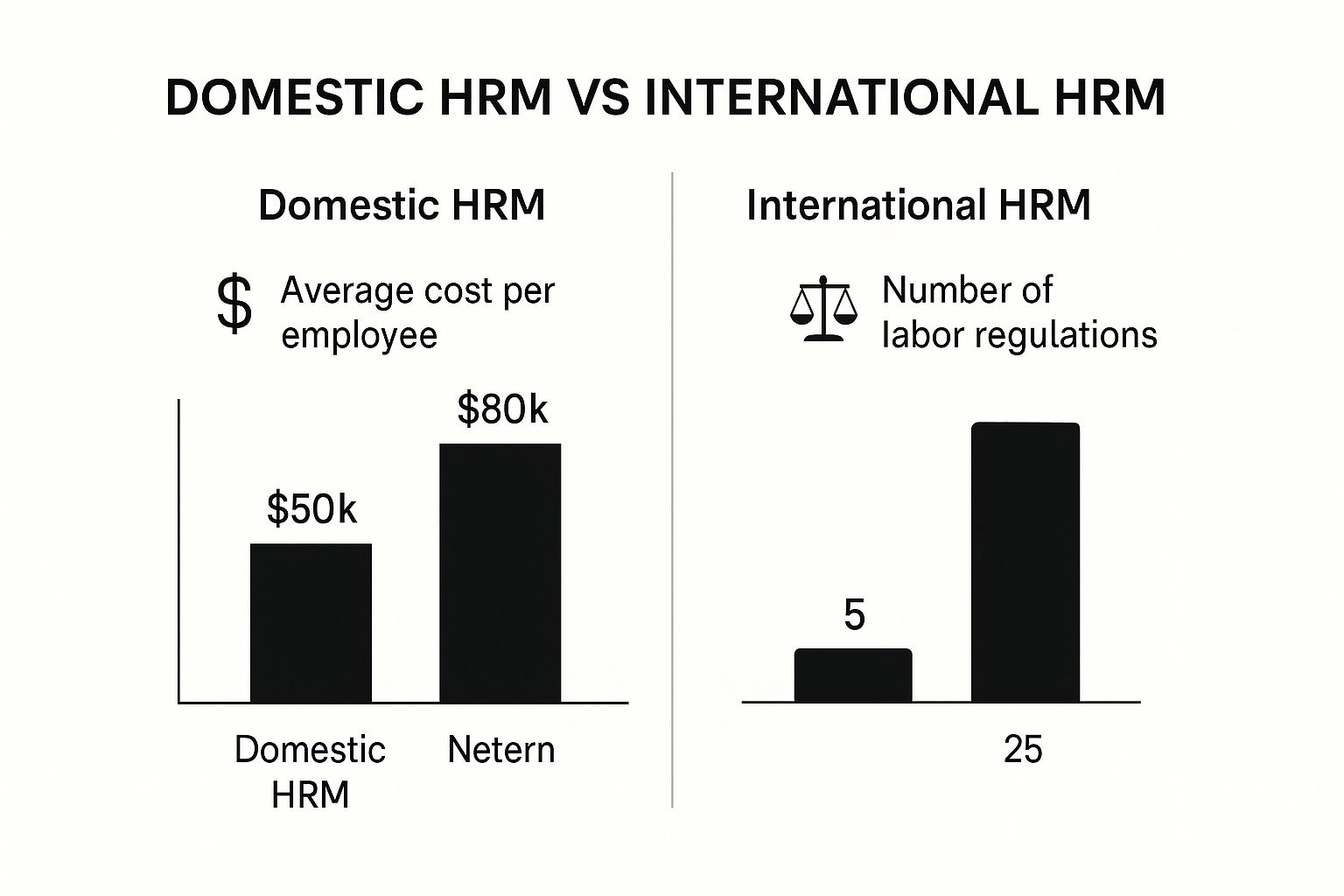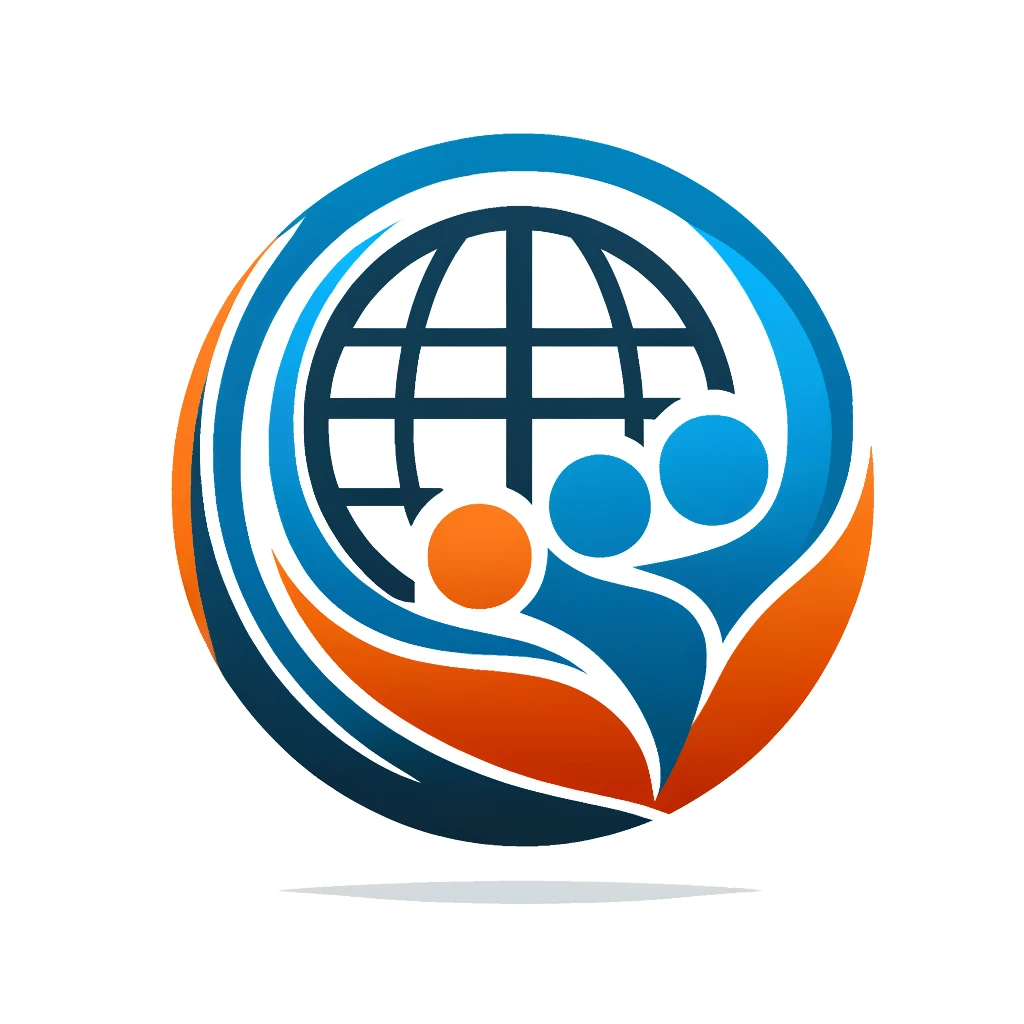The New Frontiers of International Human Resources Management

The infographic above offers a glimpse into the contrasting landscapes of domestic and international human resources management. Notice the stark difference in average cost per employee: international HRM demands significantly greater investment, reflecting the intricate challenges involved. The sheer volume of international labor regulations also presents a considerable hurdle, underscoring the need for specialized HR expertise.
This disparity means organizations with a global presence must dedicate more resources and cultivate specific skills to effectively manage their international teams. Embracing these complexities is key to unlocking the immense potential of a global workforce.
To better illustrate these differences, let's explore a comparison table. This table highlights the key distinctions between managing human resources domestically versus internationally, showcasing the additional complexities that HR professionals face in global contexts.
| Function Area | Domestic HR Focus | International HR Considerations |
|---|---|---|
| Compensation & Benefits | Designing competitive salary and benefits packages aligned with local market rates. | Adapting compensation and benefits to different countries, considering local regulations, tax implications, and cultural expectations. |
| Legal Compliance | Adhering to national labor laws and regulations. | Navigating a complex web of international labor laws, tax regulations, and data privacy laws across multiple jurisdictions. |
| Talent Acquisition | Recruiting and onboarding talent within the domestic market. | Sourcing, recruiting, and onboarding talent from diverse international markets, considering cultural differences and language barriers. |
| Performance Management | Evaluating employee performance based on established domestic standards. | Implementing performance management systems that account for cultural nuances and varying international performance expectations. |
| Training & Development | Providing training programs focused on domestic business practices. | Designing and delivering culturally sensitive training programs that address the unique challenges of working in a global environment. |
As the table reveals, international HR management requires a broader perspective and a deeper understanding of global nuances. This added layer of complexity, while challenging, presents opportunities for growth and innovation.
The Evolving Role of HR Leaders
One of the most profound transformations in international human resources is the evolving role of HR leadership. HR leaders are no longer just administrators; they are strategic architects, shaping business value and steering their organizations through complex global currents. They play a vital role in cultivating culturally intelligent leaders who can inspire and manage diverse teams across international borders.
This includes championing global leadership development programs and crafting compensation strategies that transcend cultural boundaries. By 2025, a projected 75% of HR leaders anticipate that managers will be overwhelmed, while 70% report their current leadership programs are inadequate for future needs. This emphasizes the urgent need for HR to empower leaders with the skills necessary for success in the global arena. Learn more about the top priorities for HR leaders here. For increased efficiency, consider automating HR processes here.
Global Talent Acquisition and Mobility
Attracting, recruiting, and retaining top-tier talent from a global pool is another crucial aspect of international human resources. This requires crafting compelling employer value propositions that resonate with candidates from diverse cultural backgrounds while maintaining a consistent global brand identity.
Furthermore, international HR professionals must navigate diverse educational systems, professional certifications, and candidate expectations across different regions. This global perspective on talent acquisition broadens the talent pool and enriches the organization with diverse perspectives.
Navigating The Regulatory Landscape
International human resources management also entails navigating a complex tapestry of legal and regulatory requirements, each unique to its respective country. HR professionals must ensure compliance with local labor laws, tax regulations, data privacy legislation, and other relevant statutes.
This encompasses managing international assignments, ensuring tax compliance for mobile employees, and structuring compensation and benefits packages that align with local regulations. This demands a nuanced understanding of local legal frameworks and the adaptability to tailor HR policies and practices accordingly.
Building Cultural Intelligence That Drives Business Results

Beyond basic diversity training lies the real strength of cultural intelligence within international human resources management. It's about understanding and respecting cultural differences, and then using that knowledge to reach your business goals. Leading global organizations are now using frameworks that turn these differences from potential challenges into valuable strengths. This builds a work environment where unique perspectives boost creativity, problem-solving, and ultimately, the bottom line.
Developing Culturally Intelligent Leaders
A key part of building cultural intelligence is developing leaders who can successfully navigate the complexities of global business. It's more than just recognizing that cultures are different; it's about actively developing cultural sensitivity and adaptability. For instance, a culturally intelligent leader understands that communication styles, decision-making processes, and leadership expectations can change from culture to culture.
This allows them to adapt their leadership approach to build trust and positive relationships with teams around the world. These leaders are skilled at resolving conflicts, encouraging collaboration, and fostering a true sense of belonging for every team member, no matter their background.
Reimagining Performance Management
Traditional performance management systems may not work well for a globally diverse workforce. Cultural differences can heavily influence how performance is seen and measured. As a result, HR leaders are innovating these systems to make sure they consider cultural factors without losing accountability. This means adjusting performance metrics, feedback methods, and reward systems to match cultural norms and values.
For example, some cultures value teamwork and collaboration, while others may focus on individual results. A culturally intelligent performance management system accounts for these differences and adjusts the evaluation criteria accordingly. This ensures fair and precise assessments, promotes a sense of equity, and inspires employees across the entire global organization. Team effectiveness is increasingly important in international human resources management. By 2025, 64% of HR leaders expect to prioritize team effectiveness in their future-of-work strategy. This reflects how essential successful teams are for driving productivity and engagement in diverse global workplaces. More detailed statistics can be found here.
Creating Inclusive Environments
Creating a genuinely inclusive environment goes beyond simple policies and procedures. It requires a significant change in perspective and a real dedication to building a culture of respect and understanding. This means encouraging open communication, valuing different points of view, and offering chances for cross-cultural learning and sharing. Such initiatives can include cultural awareness workshops, mentorship programs, and employee resource groups.
Organizations can also create ways for employees to share their own experiences and perspectives, building a stronger sense of community and belonging. These efforts create a more engaging and dynamic workplace, where people feel valued for what makes them unique and are empowered to achieve their full potential. Through these combined efforts, organizations can unlock the full potential of their global workforce and find lasting success on the international stage.
Global Talent Acquisition That Transcends Borders

The image above symbolizes the interconnectedness of today's talent market. Finding the right people for your team, no matter where they are in the world, requires a strategic approach. It's about more than just posting jobs on international job boards. It's about understanding the unique aspects of different markets and tailoring your recruitment strategies accordingly.
Redefining Employer Value Propositions for a Global Audience
Building a strong employer value proposition (EVP) is a cornerstone of successful international talent acquisition. Your EVP is your promise to employees – what they can expect in return for their dedication and hard work. While maintaining a consistent global brand identity is essential, it’s equally important to adapt your EVP to resonate with the specific values and expectations of each local market.
This means understanding what truly motivates talent in different regions. Is it career growth, work-life balance, competitive compensation, or something else entirely? For instance, when expanding into a new market, you might emphasize different aspects of your EVP based on the local culture. Perhaps job security and benefits are paramount in one region, while opportunities for innovation and professional development take center stage in another. Adapting your EVP to these cultural nuances is essential for attracting and retaining top international talent.
Assessment Methodologies That Minimize Cultural Bias
Developing assessment methodologies that are both effective and culturally unbiased presents a significant challenge in international human resources management. Traditional methods may inadvertently favor certain cultural norms or communication styles, disadvantaging candidates from diverse backgrounds.
A more nuanced approach is required. This might involve incorporating a combination of assessment techniques such as interviews, skills-based assessments, and personality tests. Structured interview formats and training for interviewers to recognize and mitigate unconscious bias can also contribute to a fairer and more equitable selection process. This not only promotes fairness but also increases the likelihood of selecting the candidates who are truly the best fit, regardless of their cultural background.
Navigating Diverse Educational Systems and Qualifications
International recruiters also face the task of navigating diverse educational systems and professional qualifications around the world. The definition of a strong academic background or relevant professional experience can vary significantly from country to country.
Recruiters need a deep understanding of the educational landscape and professional certifications valued in each target market. They must learn how to interpret international credentials and evaluate candidates' skills and experience in a way that's fair and relevant to the job requirements. This knowledge enables them to make informed hiring decisions and select candidates who possess the necessary skills and knowledge to excel, no matter where they earned their qualifications.
Managing Expatriate Assignments and Local Hiring
International human resources management often requires strategic decisions about when to utilize expatriate assignments and when to hire locally. While expatriate assignments can be valuable for transferring knowledge and skills, they often involve substantial costs and logistical challenges. Finding the right balance between international mobility and the advantages of local hiring is key to optimizing workforce deployment and managing expenses. This involves developing robust processes for selecting and supporting expatriates, as well as building strong relationships with local talent pools. Creating efficient interviewing processes that transcend time zones and cultural differences, potentially leveraging video conferencing and adapting interview questions for cultural appropriateness, is also crucial for successful international recruitment. By carefully considering these factors, companies can build strong international teams and effectively manage their global workforce.
Navigating the Regulatory Maze of International HR

The image above depicts the intricate web of regulations that international human resources professionals must navigate. Successfully managing a global workforce isn't simply about understanding different legal systems. It’s about crafting strategies to ensure consistency and compliance across international borders. This requires a careful balance between global standardization and adapting to local customs and regulations.
Understanding the Global Regulatory Landscape
One of the biggest hurdles in international HR is the sheer variety of legal and regulatory environments. Employment laws, tax regulations, data privacy legislation, and labor relations practices differ significantly from one country to another. This means HR professionals must have a deep understanding of the specific requirements of each region where their company operates.
For example, grasping the nuances of contract law, termination procedures, and mandatory benefits can be the difference between seamless operations and expensive legal disputes. Staying informed about regulatory changes is equally crucial. Laws are always evolving, and what's compliant now might not be tomorrow.
This demands a proactive approach to monitoring regulatory updates and making the necessary changes to company policies and procedures. Continuous monitoring and adaptation are key to minimizing risk and maintaining legal compliance. Certain regions stand out when it comes to the concentration of HR professionals. In the United States, California, Texas, New York, Florida, and Illinois have the highest numbers of HR representatives. The District of Columbia, Washington, New Jersey, California, and New York offer the top salaries for HR professionals. This underscores the importance of these areas in international human resources, as large companies often base their operations there, requiring strong HR departments. Find more detailed statistics here.
Balancing Global Standardization and Local Compliance
While adhering to local regulations is essential, multinational organizations also benefit from maintaining consistency in their HR policies. This consistency fosters a unified company culture, streamlines operations, and ensures fair treatment of employees worldwide. Achieving this balance can be complicated, but it's a worthwhile pursuit.
It calls for establishing clear frameworks for deciding when to adapt and when to standardize. For example, core values like equal opportunity and non-discrimination should be globally consistent. However, the practical application of these principles might need adjusting to align with local laws and cultural norms.
Structuring International Assignments and Ensuring Tax Compliance
Managing international assignments adds another layer of complexity. This includes designing compensation and benefits packages that are both competitive and compliant with local regulations, as well as ensuring tax compliance for employees working abroad. Navigating international tax laws can be a major challenge and often requires expert advice.
HR professionals must also consider the cultural and logistical aspects of international assignments. Providing support for employees and their families as they relocate and adjust to new environments is vital. This support could include language training, cultural orientation, and assistance with housing and schooling. Addressing these factors effectively is crucial for successful international assignments and the well-being of employees living and working abroad.
To further illustrate the complexities involved, consider the following table:
International HR Compliance Considerations
This table presents key regulatory areas that international HR professionals must navigate across different regions, highlighting major differences that impact global workforce management.
| Region | Employment Laws | Benefits Requirements | Data Privacy Regulations | Labor Relations |
|---|---|---|---|---|
| European Union | Strong employee protections, works councils common | Comprehensive social security systems | GDPR (General Data Protection Regulation) | Collective bargaining agreements prevalent |
| United States | At-will employment common, varying state laws | Employer-sponsored healthcare common | HIPAA (Health Insurance Portability and Accountability Act), CCPA (California Consumer Privacy Act) | Unionization less common than in EU |
| East Asia | Emphasis on seniority, complex termination procedures | Statutory benefits, cultural variations | Varying regulations, increasing focus on data security | Emphasis on harmony and consensus |
| Latin America | Varied regulations, employment contracts important | Statutory benefits, social security systems | Emerging data privacy frameworks | Unionization rates vary |
This table provides a simplified overview. The specific regulations within each region can vary significantly by country. Understanding these nuances is essential for effective international HR management.
Creating Compensation Strategies That Work Across Cultures
Crafting compensation strategies that truly resonate across cultures within international human resources management is a multifaceted journey. It extends far beyond simply analyzing numbers and market trends. It demands a genuine understanding of cultural nuances and the delicate art of balancing internal equity with external competitiveness, all while respecting the unique characteristics of diverse local markets. This means going deeper than simply the what of compensation—salary and benefits—and considering the how and why—how compensation is perceived and why it motivates individuals in different cultural contexts.
Cross-Border Compensation Benchmarking
One of the foundational steps in building a globally effective compensation strategy is cross-border compensation benchmarking. This process involves comparing compensation levels for similar roles across different countries. It necessitates considering both quantitative data, like salary surveys, and qualitative factors, such as cost of living, local market conditions, and cultural expectations.
For example, a software engineer in Silicon Valley might command a higher salary than their counterpart in Bangalore, India, due to differences in cost of living and market demand. However, simply adjusting salaries based on these quantitative measures isn't enough. It's vital also to consider the value placed on different components of compensation. In some cultures, benefits like healthcare and retirement plans hold greater weight than a slightly higher base salary.
Harmonizing Benefits Across Cultures
Harmonizing benefits across diverse cultures presents a unique set of challenges. What is considered standard in one country might be unusual or even unnecessary in another. For instance, robust public healthcare systems in some European countries might diminish the importance of employer-sponsored health insurance, while in other regions, it’s an essential component of a competitive benefits package. Cultural factors also play a crucial role. Some cultures place a high value on benefits that support family well-being, such as parental leave or childcare subsidies.
Legal requirements for benefits vary significantly between countries, as well. International human resources teams must remain informed about these differences to ensure compliance. When expanding globally, understanding the nuances of legally compliant background checks is paramount. Simplifying this process can be achieved by following practical tips outlined in resources like those available at International Background Checks. This diligence builds trust with employees and demonstrates respect for local customs and regulations.
Addressing Currency Fluctuations and Cost-of-Living Disparities
The ever-changing nature of global markets introduces further complexity. Currency fluctuations can significantly affect the value of compensation, while cost-of-living disparities between countries necessitate regular adjustments to maintain fairness. Effective strategies for managing these complexities include pegging salaries to a stable currency like the US dollar, conducting regular cost-of-living analyses, and offering location-based allowances to offset expenses in high-cost areas. For instance, a company might offer a housing allowance to employees relocating to a city with a significantly higher cost of living than their previous location.
Developing Culturally Relevant Performance Rewards
Finally, designing performance reward systems that resonate across cultures is essential for inspiring a global workforce. This requires understanding the drivers of performance in different cultural contexts. Some cultures may emphasize individual achievements, while others prioritize teamwork and collaboration. Reward systems should be aligned with these values. This might involve implementing team-based bonuses in some regions and individual performance incentives in others. Recognition programs, too, should be tailored to cultural preferences. Public praise might be motivating in some cultures, while private acknowledgement may be preferred in others. By acknowledging these cultural subtleties, international human resources teams can develop compensation strategies that attract, retain, and motivate the best talent worldwide.
Harnessing Technology To Transform Global HR Operations
The world of international human resources management is evolving. The way global teams connect, collaborate, and contribute is being redefined by technology. This isn't just about boosting efficiency; it's a fundamental shift in how global workforces operate. Progressive organizations are embracing digital tools to overcome traditional hurdles like distance, time zones, and cultural nuances, fostering truly interconnected and agile global teams.
The Power of Global HR Information Systems
One of the most significant advancements in international HR is the Global HR Information System (GHRIS). These systems provide a central hub for managing employee data worldwide, simplifying a range of HR processes, from onboarding to payroll and benefits administration. However, implementing a GHRIS requires careful consideration.
Data privacy and security are paramount, especially given the varying regulations across different jurisdictions. A successful GHRIS implementation involves meticulous planning to ensure compliance with local laws while maintaining a unified global system. This includes choosing systems with robust security features and adaptable data access controls to address diverse regional requirements.
AI-Powered Analytics For Strategic Decision-Making
Artificial intelligence (AI) is also reshaping international human resources management. AI-driven analytics offer invaluable insights into global workforce trends, empowering more strategic decision-making.
- Identify skills gaps
- Predict employee turnover
- Optimize talent allocation
For instance, AI can analyze employee performance data across multiple countries to pinpoint high-potential individuals for leadership development programs. This data-driven approach enables HR to be proactive, anticipating workforce needs and developing targeted interventions to boost performance and engagement. Organizations can make more informed decisions about talent deployment, career development, and workforce planning.
Implementing HR Technology Across Diverse Digital Landscapes
One of the biggest challenges in leveraging technology for international HR is navigating the diverse digital landscapes worldwide. Digital infrastructure, internet access, and user expectations vary significantly from region to region. A solution that works seamlessly in one country might be impractical in another.
Organizations need a flexible and adaptable approach to HR technology implementation. This might involve:
- Providing training and support for employees in regions with lower levels of digital literacy.
- Tailoring systems to accommodate varying levels of internet access.
User experience is key. Systems must be intuitive and easy to use for employees from diverse cultural backgrounds, regardless of their prior experience with HR technology. Considering these factors ensures technology enhances, rather than hinders, global HR operations. Understanding the specific needs and expectations of each region is crucial for successful technology adoption.
Revolutionizing Core International HR Processes
Technology is revolutionizing core HR processes, from onboarding to performance management. Digital onboarding platforms streamline the integration of new international hires, equipping them with the information and resources they need to quickly acclimate to their new roles. Digital performance management systems enable real-time feedback and performance tracking, fostering more frequent and effective communication between managers and employees across locations.
This enhanced communication cultivates a more engaged and productive global workforce. This isn't simply about digitizing existing processes; it's about reimagining how these processes can be optimized for a global context.
For those looking to enhance their skills in this dynamic field, the Global Human Resource Institute (GHRI) offers a range of courses and certifications tailored to the demands of modern international human resources management. From fundamental principles to advanced strategies, GHRI provides the tools and resources you need to thrive in the global HR arena.




0 Comments